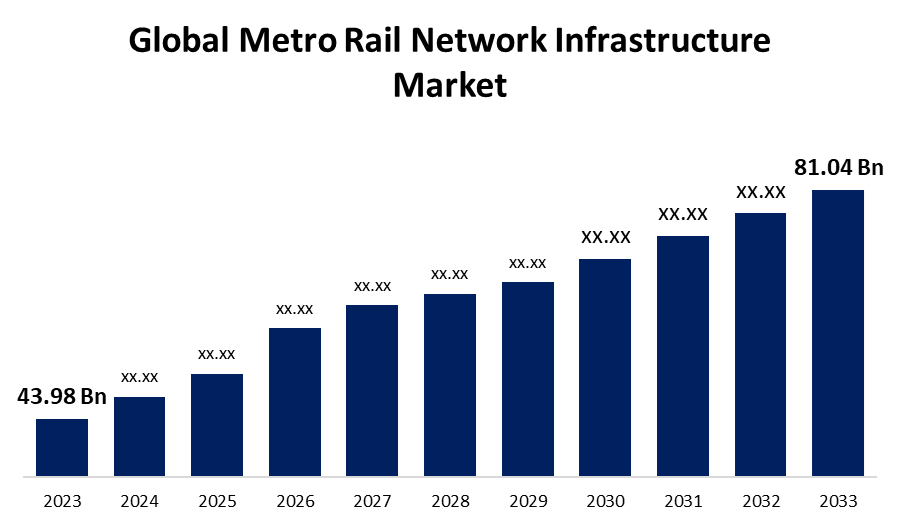Global Metro Rail Network Infrastructure Market Size, Share, and COVID-19 Impact Analysis, By Structure (Elevated, At Grade Level, and Underground), By Application (Rolling Stock, Station, Track System, Signal & Telecommunication System, Power Supply System, Ticketing System, and Others), and By Region (North America, Europe, Asia-Pacific, Latin America, Middle East, and Africa), Analysis and Forecast 2023 - 2033
Industry: Automotive & TransportationGlobal Metro Rail Network Infrastructure Market Insights Forecasts to 2033
- The Global Metro Rail Network Infrastructure Market Size was Estimated at USD 43.98 Billion in 2023
- The Market Size is Expected to Grow at a CAGR of around 6.30% from 2023 to 2033
- The Worldwide Metro Rail Network Infrastructure Market Size is Expected to Reach USD 81.04 Billion by 2033
- North America is Expected to Grow the fastest during the forecast period.

Get more details on this report -
The Global Metro Rail Network Infrastructure Market Size is expected to cross USD 81.04 Billion by 2033, growing at a CAGR of 6.30% from 2023 to 2033.
Market Overview
The metro rail network infrastructure market refers to the industry focused on the development, construction, and modernization of metro rail systems, including tracks, stations, signaling systems, rolling stock, and power supply networks. Rapid urbanization, rising government spending, technological developments like automation and digital ticketing, a growing focus on environmental sustainability, the need for efficient transit solutions due to population density, and public-private partnerships that encourage funding and innovation are the main factors driving the metro rail network infrastructure market. All of these elements work together to support metro rail networks' ongoing development and upgrading across the globe. Additionally, according to ICRA, rapid urbanization, rising demand for effective public transportation, government emphasis on infrastructure development, and technological advancements in metro rail systems will all contribute to the domestic metro rail projects' potential to generate Rs 80,000 crore in business opportunities for construction companies over the next five years. Together, these elements spur industry innovation and investment, enhancing metro rail's position as an essential part of urban mobility.
Report Coverage
This research report categorizes the metro rail network infrastructure market based on various segments and regions forecasts revenue growth and analyzes trends in each submarket. The report analyses the key growth drivers, opportunities, and challenges influencing the metro rail network infrastructure market. Recent market developments and competitive strategies such as expansion, type launch, development, partnership, merger, and acquisition have been included to draw the competitive landscape in the market. The report strategically identifies and profiles the key market players and analyses their core competencies in each sub-segment of the metro rail network infrastructure market.
Global Metro Rail Network Infrastructure Market Report Coverage
| Report Coverage | Details |
|---|---|
| Base Year: | 2023 |
| Market Size in 2023: | USD 43.98 Billion |
| Forecast Period: | 2023 - 2033 |
| Forecast Period CAGR 2023 - 2033 : | 6.30% |
| 2033 Value Projection: | USD 81.04 Billion |
| Historical Data for: | 2019 - 2022 |
| No. of Pages: | 240 |
| Tables, Charts & Figures: | 100 |
| Segments covered: | By Structure, By Application and By Region |
| Companies covered:: | Bombardier Transportation, Alstom SA, Siemens Mobility, Hitachi Rail, CRRC Corporation Limited, General Electric (GE Transportation), CAF (Construcciones y Auxiliar de Ferrocarriles), Hyundai Rotem, Talgo, Mitsubishi Heavy Industries, China Railway Construction Corporation (CRCC), Larsen & Toubro (L&T), and Others |
| Pitfalls & Challenges: | COVID-19 Impact, Challenges, Future, Growth, & Analysis |
Get more details on this report -
Driving Factors
One of the key factors contributing to the growth of the global metro rail network infrastructure market includes increased global population, and also the rapid growth of smart cities is driving the need for railways, which is further fueling the market growth and development. Additionally, there is a rising demand for effective and sustainable transportation options because railway transportation produces less pollution compared to other transportation services. Additionally, the Mumbai Metropolitan Region Development Authority plans to finish the 337 km of metro rail line by 2026, allowing passengers to travel throughout the entire city in 60 minutes. As 180 km of metro work is completed across nine corridors, this expansion and advancement is expected to propel significant growth in the metro rail infrastructure sector.
Furthermore, from Fiscal Year 2022 to 2026, the Infrastructure Investment and Jobs Act (IIJA) approved $66 billion for rail projects, enabling critical upgrades like the development of Amtrak corridors, the expansion of intercity passenger train service, and the grade separation of road-rail crossings. Government expenditures and funding allocations for rail infrastructure are expected to increase, which will promote technological improvements, improve connectivity, and fortify economic prospects in the global metro rail network infrastructure market.
Restraining Factors
The establishment of metro rail networks, however, necessitates a large initial capital outlay for equipment, technology, site acquisition, and construction. Governments and private investors frequently find the large financial investment difficult to manage, especially in areas with competing priorities or little money for infrastructure, which restricts market expansion.
Market Segmentation
The metro rail network infrastructure market share is classified into structure and application.
- The elevated segment held the significant share in 2023 and is anticipated to grow at a significant CAGR during the forecast period.
Based on the structure, the metro rail network infrastructure market is divided into elevated, at grade level, and underground. Among these, the elevated segment held the significant share in 2023 and is anticipated to grow at a significant CAGR during the forecast period. Elevated systems are more economical and quicker to install in crowded urban settings because they require less land acquisition than their underground counterparts.
- The station segment held the significant share in 2023 and is anticipated to grow at a significant CAGR during the forecast period.
Based on the application, the metro rail network infrastructure market is divided into rolling stock, station, track system, signal & telecommunication system, power supply system, ticketing system and others. Among these, the station segment held the significant share in 2023 and is anticipated to grow at a significant CAGR during the forecast period. There are a number of reasons behind the growth of metro rail stations that are intended to enhance sustainability and urban mobility. The necessity for effective transportation systems rises with urban population density, leading authorities to extend metro networks to meet the demands of commuting.
Regional Segment Analysis of the Metro Rail Network Infrastructure Market
- North America (U.S., Canada, Mexico)
- Europe (Germany, France, U.K., Italy, Spain, Rest of Europe)
- Asia-Pacific (China, Japan, India, Rest of APAC)
- South America (Brazil and the Rest of South America)
- The Middle East and Africa (UAE, South Africa, Rest of MEA)
Asia Pacific is anticipated to hold the significant share of the metro rail network infrastructure market over the predicted timeframe.

Get more details on this report -
Asia Pacific is anticipated to hold the significant share of the metro rail network infrastructure market over the predicted timeframe. Asia Cities in Asia Pacific suffer major transportation issues, such as pollution and traffic, as a result of their rapidly growing populations and urbanization. The region's governments are making significant investments in metro rail networks as a long-term way to deal with these problems. Furthermore, the need for pleasant and effective public transit options is being driven by strong economic growth and rising disposable incomes. In addition, metro networks are expanding to accommodate the region's expanding urban population and support regional economic development due to urbanization and the need for connectivity.
North America is expected to grow at the fastest CAGR growth of the metro rail network infrastructure market during the forecast period. The growth and development of metro infrastructure are greatly aided by government investment and support. Planning, building, and maintaining metro networks sometimes require funding from the federal, state, and municipal governments. The Biden Administration, for example, awarded USD 1.64 billion in November 2023 to support the extension of Metro-North Railroad's connection to Penn Station, including the construction of four new stations in the Bronx.
Competitive Analysis:
The report offers the appropriate analysis of the key organizations/companies involved within the metro rail network infrastructure market along with a comparative evaluation primarily based on their type of offering, business overviews, geographic presence, enterprise strategies, segment market share, and SWOT analysis. The report also provides an elaborative analysis focusing on the current news and developments of the companies, which includes type development, innovations, joint ventures, partnerships, mergers & acquisitions, strategic alliances, and others. This allows for the evaluation of the overall competition within the market.
List of Key Companies
- Bombardier Transportation
- Alstom SA
- Siemens Mobility
- Hitachi Rail
- CRRC Corporation Limited
- General Electric (GE Transportation)
- CAF (Construcciones y Auxiliar de Ferrocarriles)
- Hyundai Rotem
- Talgo
- Mitsubishi Heavy Industries
- China Railway Construction Corporation (CRCC)
- Larsen & Toubro (L&T)
- Others
Key Target Audience
- Market Players
- Investors
- End-users
- Government Authorities
- Consulting And Research Firm
- Venture capitalists
- Value-Added Resellers (VARs)
Market Segment
This study forecasts revenue at global, regional, and country levels from 2023 to 2033. Spherical Insights has segmented the metro rail network infrastructure market based on the below-mentioned segments:
Global Metro Rail Network Infrastructure Market, By Type
- Elevated
- At Grade Level
- Underground
Global Metro Rail Network Infrastructure Market, By Application
- Rolling Stock
- Station
- Track System
- Signal & Telecommunication System
- Power Supply System
- Ticketing System
- Others
Global Metro Rail Network Infrastructure Market, By Regional Analysis
- North America
- US
- Canada
- Mexico
- Europe
- Germany
- UK
- France
- Italy
- Spain
- Russia
- Rest of Europe
- Asia Pacific
- China
- Japan
- India
- South Korea
- Australia
- Rest of Asia Pacific
- South America
- Brazil
- Argentina
- Rest of South America
- Middle East & Africa
- UAE
- Saudi Arabia
- Qatar
- South Africa
- Rest of the Middle East & Africa
Frequently Asked Questions (FAQ)
-
1. What is the CAGR of the metro rail network infrastructure market over the forecast period?The metro rail network infrastructure market is projected to expand at a CAGR of 6.30% during the forecast period.
-
2. What is the market size of the metro rail network infrastructure market?The Global Metro Rail Network Infrastructure Market Size is Expected to Grow from USD 43.98 Billion in 2023 to USD 81.04 Billion by 2033, at a CAGR of 6.30% during the forecast period 2023-2033.
-
3. Which region holds the largest share of the metro rail network infrastructure market?Asia Pacific is anticipated to hold the largest share of the metro rail network infrastructure market over the predicted timeframe.
Need help to buy this report?